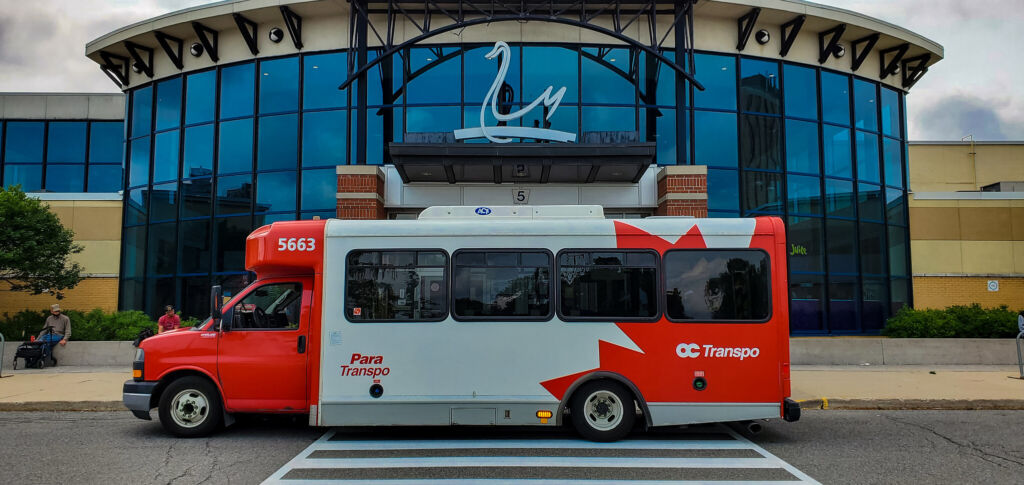2020 began like every other year for Para Transpo riders in Ottawa: waiting. Waiting for online booking, waiting for same-day booking and waiting to be treated with the respect and dignity afforded to riders of conventional transit. Ridership plunged across all transit services at the start of the pandemic: 10,677 Para Transpo trips were logged in April 2020 compared to 76,946 in April 2019, an 86% year-over-year drop that mirrors statistics for conventional transit. Pre-pandemic ridership is still far away, but para transit is regularly 5% to 10% closer to “normal” levels. With para transit, the post-COVID question is not just how to win back riders—since fewer para transit riders have access to private vehicles—rideshares or other mobility options. Rather, the question becomes how to improve the rider experience and end the paternalism and ableism that are entrenched in para transit services.
Thinking about current para transit service, the adage of Hanlon’s razor comes to mind, “never attribute to malice that which is adequately explained by st***dity.” That adage, which itself includes an ableist slur, can be applied to many city policies, but not where paternalism and ableism underpin transit operations. Para Transpo assumes that para riders’ time is not valuable, that they have few important obligations and that their lives should be limited due to mobility and accessibility needs.
For example, until December 2021, the number of daily Para Transpo trips per rider was capped at four. While four trips might seem sufficient, a round trip to a destination and back represents two trips. So, a para transit rider could only take two round trips in a day. The fact that many people with accessibility needs have jobs, social engagements and family responsibilities is completely overlooked: the underlying assumption is that para transit should be a “less than” service option that only ferries disabled people to and from doctors’ appointments, pharmacies and grocery stores. If someone who happens to use a wheelchair, on a workday, needed to stop on their way home to run errands, they would not be able to go out with friends in the evening as this would exceed the four rides per day maximum.
Riders have long complained about limited hours: Para Transpo service stops at midnight, impacting those who work late nights or want to go out with friends. For shift workers, this means missing out on work opportunities. For those who enjoy movies, concerts or nights out with friends, this means carefully scheduling to ensure that a ride is available and often having to leave early or miss out on fun. There is also no accommodation for late-night medical transport, meaning that para riders must call an ambulance (or stay in hospital overnight), which is far more costly and less convenient since ambulances are not designed to accommodate a rider and their mobility device.
While the problems are legion, many would be easy and quick to solve with political will and a recognition of para riders as important citizens who deserve quality service that treats them as equals.
Looking at OC Transpo’s on-time performance standards, it is clear that para riders’ time is considered less valuable than that of other transit riders. Conventional bus and train service standards measure fractions of a minute that a transit vehicle is late or early; para transit performance measures the number of trips that arrive within a 30 minute window, leaving riders waiting for far longer periods of time, ones which would be considered unacceptable by conventional transit customers. In addition, riders who use telephone booking usually wait on hold for 30 minutes or more for a para transit operator to take a booking, with the call-back option often taking hours.
While the problems are legion, many would be easy and quick to solve with political will and a recognition of para riders as important citizens who deserve quality service that treats them as equals. Fixing para transit means putting equity first!
With that in mind, what should the future of para transit look like? Sally Thomas, one of the authors and an equitable transit champion, sees potential to make the system more efficient by improving logistics. If she wants to go see a movie with another para rider, Para Transpo will often deploy two buses, even when they are starting from the same origin and heading to the same destination at the same time. Better coordination for these sorts of trips would be a far more efficient use of vehicles and would also offer the riders the dignity and basic decency of riding together like conventional transit riders. Finding the most efficient routes between destinations would improve transit speeds, saving fuel and time and minimizing riders’ frustrations.
According to Kyle Humphrey, an Ottawa-based accessibility advocate, equity would be the freedom to say “yes.” Humphrey is tired of being treated as a second-class citizen and wants to see a future where he and other para riders can have an active social life, say yes to last minute invitations to events and gatherings, plan to stay out past midnight and have the same quality experience as conventional transit riders. He also wants to ensure that Para Transpo offers reasonable options that other transit agencies have offered for years, including the ability to book based on either a pick-up time or a drop-off time instead of using pick-up times as the only option. These simple changes would offer riders enormous time savings and improve their quality of life.
Richard Frederick is a retired school bus driver who was accustomed to traveling on his own schedule. A senior with mobility challenges, he prefers para transit service over taxis or relying on rides from friends, but he still sees room for improvement. He needs better integration with Gatineau’s para transit service for easier access to his medical appointments and to visit family and friends. Frederick does not use a computer and finds that the long waits he endures when he calls the booking line make him anxious: he worries that his phone battery might die while he waits on hold, or if he requests a call-back, that the call will come too late to accommodate his booking. He wants a system that respects his time and one that offers the basic dignity of a call or text if his bus is running late.
Making improvements in some of these areas is easy; in others, costly. A long-standing option for para riders has been to use conventional transit, especially in months without snow cover. For riders who use mobility devices, the para transit network should include the entire regular service network, plus the additional mobility offered by para transit. However, this speed and convenience is seasonal due to Ottawa’s climate; riders need better solutions for winter service challenges and snow clearing.
Para transit offers a door-to-door solution, but to truly advance equity a City’s entire transit network—including all para and conventional transit vehicles and stops—should be fully accessible for individuals who use wheelchairs, walkers and other mobility devices, or who have other accessibility needs. Making this happen means centring on, listening to and learning from para riders’ experiences and taking action to advance equity. In Ottawa, creating a barrier-free transit network requires addressing long-standing built infrastructure gaps, including its many inaccessible bus stops. These include stops located on narrow sidewalks without space to deploy a bus’s ramp and allow a wheelchair user to roll off; roadside stops without platforms; stops without sidewalks, ramps or crosswalks; and stops without seating for riders who need to sit while waiting for their bus. Some of these problems can be easily fixed; others, however, require full street redesigns that would improve safety and accessibility for all users.
The City constantly espouses equity; but their actions rarely match their words! A big improvement to not only transit; but all aspects would be to drastically improve how the City communicates with its residents. This includes overhauling the user experience of their website. We are a growing city, with a growing disabled population. Why not use users’ lived experiences to gain insight on improving the experiences of end users? Consultations must be better advertised in both conventional and social media. They must be communicated in a variety of modalities like large print for people with visual disabilities and closed-captioned, for deaf and hard of hearing residents. So many decisions at Council are made ahead of these consultations. Opening up opportunities for people to actively engage will ensure the continuation of innovative ideas and help Ottawa become the leader it strives to be!
Being equitable and caring is a choice, and one that our civic leaders should dare to make.
Header image by lezumbalaberenjena, used under CC0










